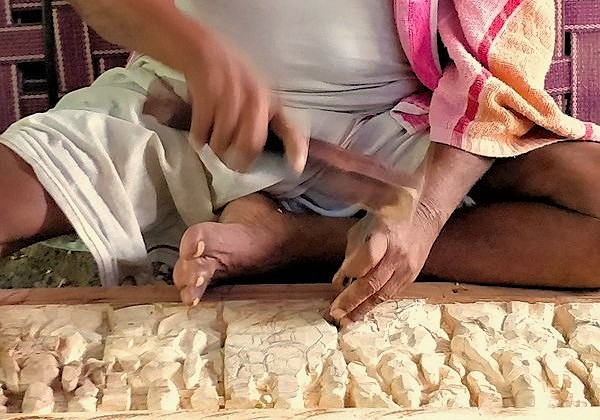Discover Life Travel
Marble Cottage Agra India
Mother Masala Tours
A Home to Generational Craftsmanship
Marble Cottage Agra India. This place is more than a workshop for creating exquisite inlay art, it serves as a living testament to centuries of Mughal craftsmanship. Located on the banks of the Yamuna River in northern India, this site continues the legacy of intricate stone work that was first established during the time of Emperor Shah Jahan. Known for commissioning the Taj Mahal, Shah Jahan also set the foundation for creating this artistic hub in the 17th century. The artisans of Marble Cottage have inherited and preserved the skills that produced the opulent designs embedded in Agra’s imperial history.

Marble Cottage Agra India: Timeless Artifacts
The Cottage stands as a hoard of carefully crafted objects that resonate with a deep sense of history. Many of the intricate inlay designs you witness here channel the same artistry found in Agra’s famed Taj Mahal, blending patterns and colors into striking works of art. Such creations are inspired by Mughal aesthetics while remaining grounded in local influences. The creation of marble inlay, or parchin kari, is rooted in a meticulous process that dates back more than 400 years. Crafting mosaics from semi-precious stones such as lapis lazuli, malachite, and jasper involves immense patience, precision, and talent.
Capturing the Magic: A Photographic Haven

You find many subjects for photography in and around the marble workshop areas. The details of these creative spaces provide interesting compositions for our cameras. We can capture the clear colors of the semi-precious stone inlays set against the white marble. The process of carving the stone also makes for compelling images of the work. We document the artisans as they are focused on their specific tasks. The way light hits the polished surfaces creates different effects to photograph. We take shots of the tools, the raw materials, and the finished decorative pieces, all revealing the craft.
A Culinary Journey: Savor the Flavour
Marble Cottage Agra India. While the Cottage is best known for its artistic novelties, stepping into the local Agra community also exposes us to its culinary traditions. Local spices, seasonal vegetables, and dishes like dal and fresh roti are mainstays in artisan households. Meals are communal affairs, with generous portions feeding families as they convene during work breaks. These simple yet satisfying dishes reflect daily traditions and the culture of sharing that defines Agra’s artisan life.
The Pulse of the Local Community

The artisans belong to tightly-knit communities that have thrived for generations in Agra. These workers maintain an incredible culture of hospitality and openness, welcoming us as honored guests to witness their ancient trade. Their daily lives revolve around preserving and practicing their craft, with families often pooling their skills to contribute to larger-scale projects. This sense of unity within artisan families gives us a glimpse of how traditions remained firmly rooted in Agra’s society through centuries of external cultural influences.
Festivals of Devotion: Honouring the Sacred and the Divine
Marble Cottage Agra India. Agra thrives on its annual observance of important festivals like Eid and Diwali, both of which are celebrated fervently by the artisans of Marble Cottage. During these sacred times, activities at the workshop temporarily give way to moments of reflection, prayer, and community connection.
The Connection with the Gods

The ancient marble inlay craft in Agra is a rich blend of faiths, born from Mughal Empire patronage but passed down through both Hindu and Muslim artisan families. Before the chisel touches the stone, the spiritual groundwork is laid: Hindu craftsmen invoke Vishwakarma, the divine architect, along with Ganesha and Saraswati, seeking skill and success. Meanwhile, Muslim artisans direct reverence toward Allah, beginning their intricate work by invoking Bismillah. This powerful, shared dedication, uniting devotion to both Hindu deities and Islamic spiritual practice, is the true legacy of Agra's magnificent artistry.
Ancient Technologies: Sacred Sound, Geometry & Astrological Influences
The intricate patterns in marble inlay are known by several names, including Arabesque, which consists of flowing, plant-like designs, and geometric patterns based on repeating shapes. These designs are rooted in Islamic geometry, a system focused on creating harmony and order. Key principles include the use of repeating squares and circles that are overlapped and interlaced to form complex layouts. Mughal architecture, like the Taj Mahal, heavily emphasizes symmetry and balance. It's also believed that these designs incorporate the golden ratio, a mathematical principle used to achieve aesthetically pleasing and harmonious proportions in the final work.
Serendipitous Meetings: Beyond the Main Path

Beyond the main shops, we wander into Agra's quieter streets and find smaller marble workshops. These places reveal equally interesting techniques for working with stone and inlay. Artisans inside are not only creating items but also actively sharing their knowledge. They explain their methods and the stories behind the designs to those who show interest. These unplanned conversations offer a look into Agra’s artistic heritage. We see how traditions are maintained through this open sharing of skills and stories. The quiet industry of these side-street workshops is a constant part of the city's atmosphere.
Urban Legends: Strange Sightings, Myths and Mysteries
Marble Cottage Agra India. At places like Marble Cottage, local folklore adds a mystical dimension to the craft. A prominent tale speaks of an artisan's ghost from the Taj Mahal’s construction era. Legend says he was left unpaid for his masterful work, and his spirit now lingers, eternally bound to the city's marble creations. This narrative, whether a literal haunting or a symbolic story, represents the deep sacrifices of the craftsmen. It enriches Agra’s creative lore with a fascinating and poignant myth.
Resilience and Renewal: Overcoming Adversity’s Challenges

Artisans in Agra have weathered several generational challenges. From the decline of Mughal patronage to the rise of industrial competition, these craftspeople have shown immense resilience. The art form continues not just because of demand but because of their determination to keep this extension of history alive. We can see the careful skills passed down through many generations of local families. Each piece they create is a testament to this living cultural heritage for all. The intricate designs are revealing a story of both survival and artistry. Observing their process provides a unique look into a persistent tradition.
We’re Going Beyond the Ordinary: You’re Invited to Come With Us
You enter a world of intricacy found at the Marble Cottage, home to the artisans. This is more than a story of stone; it is an insight into a tradition of skill and patience that unfolds right here. We see the continuation of a craft passed down through many generations. The artisans' work reveals a living history, a direct link to the past. Each piece shows a dedication to preserving this unique artistic heritage. The atmosphere within the workshop is one of focused creation. This place offers a direct look at the process of making these objects. The continuity of this art form is impressive to observe. It is a very interesting and special process to see.
Symphony of Generosity: Offerings from Wanderers to Residents

The interaction at Marble Cottage involves an exchange between us and the artisans. We observe their patience and skill as they work on their craft. They sometimes share stories about their dedication and the challenges they have faced. This provides an interesting look into the continuation of their artistic methods. The exchange offers a view into the reality of maintaining these traditions in the modern day. We get a direct look at the effort that goes into each piece. This experience gives a straightforward understanding of the craft and its place in Agra. The process is a clear demonstration of their commitment to this particular art form, revealing a practical side to their work.